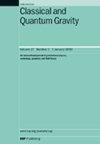利用第三代引力波探测器进行强透镜宇宙学研究
IF 3.6
3区 物理与天体物理
Q2 ASTRONOMY & ASTROPHYSICS
引用次数: 0
摘要
我们详细阐述了一种从下一代(第三代)引力波(GW)探测器观测到的大量强透镜双黑洞(BBH)合并中估算宇宙学参数的统计方法。这种方法首次发表于 Jana(2023 Phys.结果表明,宇宙学参数估计的精确度与假定的BBH红移分布模型没有很大关系。XG探测器利用大量的非凝聚合并,有望测量出BBH红移分布,并为宇宙学推断提供足够的精度。然而,BBH 红移分布推断的偏差将导致宇宙学参数估计的偏差。透镜特性分布的错误模型也会导致宇宙学推断的偏差。然而,贝叶斯模型选择可以帮助我们从一组可用的透镜分布参数模型中选择正确的模型。我们还提出了一种方法,将由于透镜识别方法效率有限而造成的数据污染影响纳入其中,使其不会对宇宙学推断产生偏差。本文章由计算机程序翻译,如有差异,请以英文原文为准。
Strong-lensing cosmography using third-generation gravitational-wave detectors
We present a detailed exposition of a statistical method for estimating cosmological parameters from the observation of a large number of strongly lensed binary-black-hole (BBH) mergers observable by next (third) generation (XG) gravitational-wave (GW) detectors. This method, first presented in Jana (2023 Phys. Rev. Lett.130 261401), compares the observed number of strongly lensed GW events and their time delay distribution (between lensed images) with observed events to infer cosmological parameters. We show that the precision of the estimation of the cosmological parameters does not have a strong dependance on the assumed BBH redshift distribution model. Using the large number of unlensed mergers, XG detectors are expected to measure the BBH redshift distribution with sufficient precision for the cosmological inference. However, a biased inference of the BBH redshift distribution will bias the estimation of cosmological parameters. An incorrect model for the distribution of lens properties can also lead to a biased cosmological inference. However, Bayesian model selection can assist in selecting the right model from a set of available parametric models for the lens distribution. We also present a way to incorporate the effect of contamination in the data due to the limited efficiency of lensing identification methods, so that it will not bias the cosmological inference.
求助全文
通过发布文献求助,成功后即可免费获取论文全文。
去求助
来源期刊

Classical and Quantum Gravity
物理-天文与天体物理
CiteScore
7.00
自引率
8.60%
发文量
301
审稿时长
2-4 weeks
期刊介绍:
Classical and Quantum Gravity is an established journal for physicists, mathematicians and cosmologists in the fields of gravitation and the theory of spacetime. The journal is now the acknowledged world leader in classical relativity and all areas of quantum gravity.
 求助内容:
求助内容: 应助结果提醒方式:
应助结果提醒方式:


